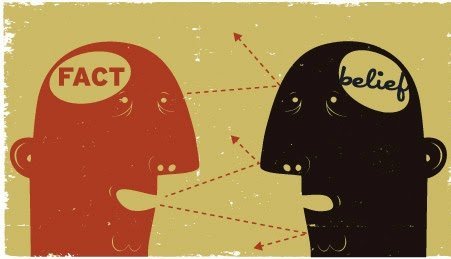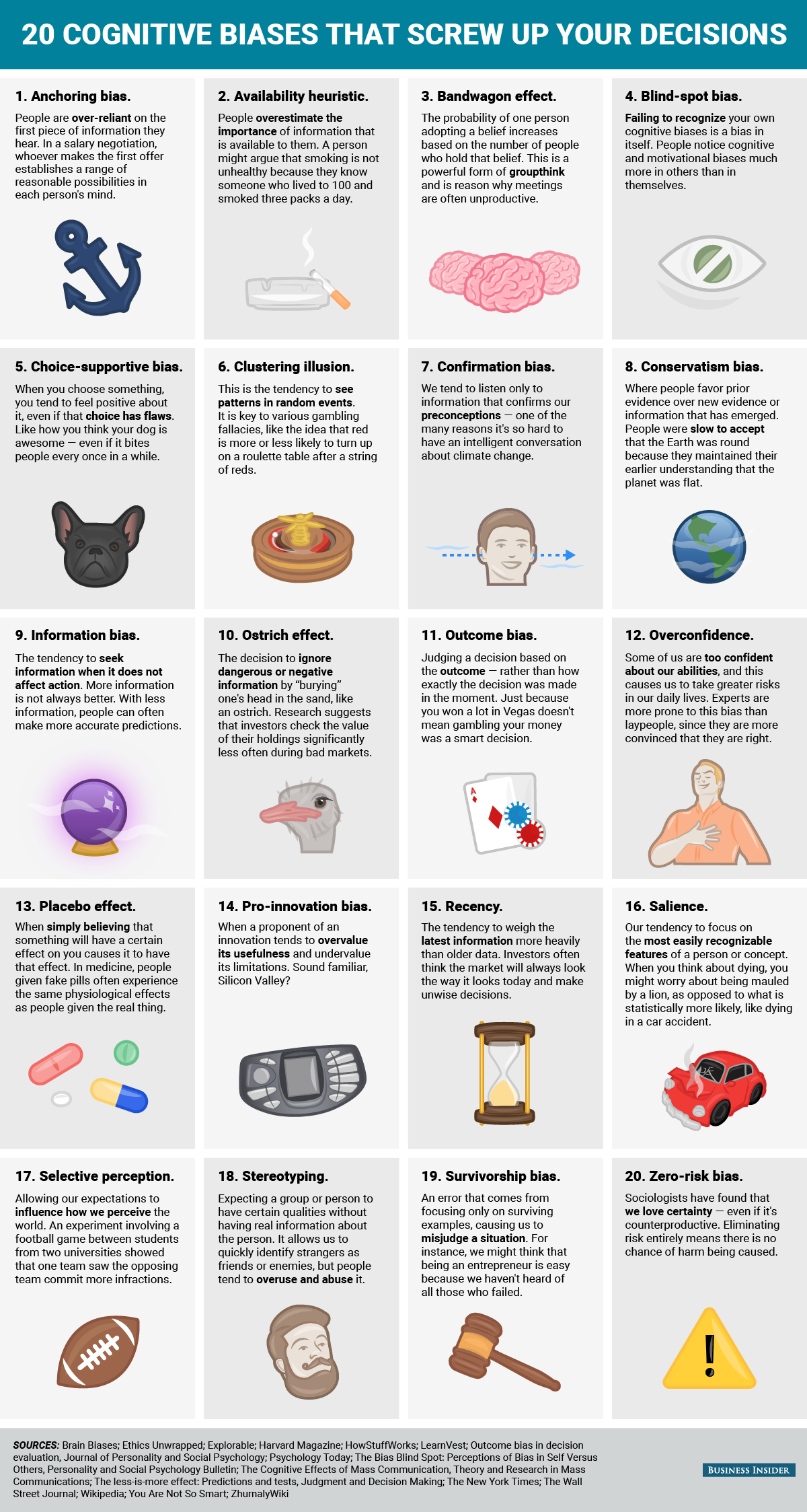
The Most Dangerous Biases in Decision Making
Adapted from my linkedin post here (feel free to check out my other articles there to!)
We see bad decisions everyday. At best we lose a few hours of productivity. At worse, entire teams are laid off, lives are lost, and opportunities are missed. Some historical examples include when Excite passed on Google for $750,000, when NBC and ABC refused broadcasting rights for Monday Night Football, and when former IBM President Thomas Watson said, “I think there is a world market for about five computers.”
So, instead of providing a list of undervalued currencies, technical analysis on ETF's, or giving some pseudo life advice, I feel the best way to help someone is to increase the accuracy and reliability of their decisions. For example, many people fall into the reactive type of decision making. We see cryptocurrencies rise so we buy in hoping it will. Someone starts yelling at us, our voices start to rise. A few tech giant and investors rushed into silicon causing boom and burst firms like Groupon. The goal is switch from reaction to a balanced mode of thinking. Introducing a pause before a decision and understanding the biases and mental processes in play.
I manage a team of design consultants and analysts and we have all become empathetic to bad decisions. We see them happen in real time everyday from discussions in small focus groups to meetings in large board rooms. Our findings are on par with much of the recent research in cognitive psychology and behavioral economics: a bad decision is the result of a myriad of cognitive errors and no one is immune to them.
In hopes that we can all become better decision makers, we have outlined in detail some of the most common biases we have noticed in our work. Much, if not all, credit goes to Daniel Kahneman and Amos Tversky for their research in cognitive psychology complied in Thinking, Fast and Slow. At the bottom of the article is also an infographic of 20 Cognitive Biases created by Samantha Lee and Shanna Lebowitz at Business Insider.
Availability Bias
Availability bias is the tendency to remember events that are more recent, personally observed, or vivid. According to the conclusions in Thinking, Fast and Slow, vividness of a memory usually trumps its frequency. If a group is asked to list three examples of when they were productive, most everyone would feel more confident in their productivity than if asked to recall 12. Almost counter intuitively, our mind becomes more skeptical as the number of supporting examples grow.
In the decision making process, availability bias leads to a myopic understanding of the broader context. One of our clients assigned homework before a pivotal meeting that would decide on the future of their content marketing strategy. Although the intention was to increase the awareness of the managers, it ironically did the complete opposite. The meeting lasted 15 mins with unanimous agreement to move forward with a new strategy. Everyone left feeling reassured only to find later on that their prior strategy was 22% more effective than their new one!
A much better tactic would have been to propose a question and ask all attendees to share their answers, justifications, and sources in the meeting. This method would have brought multiple data sets and perspectives to the table clarifying the context and prompting the discovery of new information.
Availability bias also plays a role in team dynamics. For example, we are more likely to remember our own efforts over the efforts of others. As a result, we often find ourselves thinking we are doing the brunt of the work when in all likelihood everyone else on the team is feeling they are the ones pulling the majority of the weight. Having the awareness to manage this situation can drastically increase productivity and the health of the relationships on a team.
Confirmation Bias
The one we are all familiar with. Confirmation bias is the tendency to look for sources that validate a predetermined assumption or conclusion. When everyone in a room agrees with you, that should be an immediate red flag that something is wrong.
A memorable example was a 2010 study which found that confirmation bias was extremely prevalent among financial analysts and investors. The research found that this group are extremely likely to look for information that agreed with their initial prediction. It also played a role in the prior example where everyone’s “additional research” on content marketing all agreed with the original source material provided by the CEO.
The easiest way to avoid confirmation bias is to always look for contradicting information first. Much like the scientific process, test your hypothesis by attempting, with all due diligence, to refute it.
Substitution
Are you generally happy with your life and the decisions you made so far?
In close inspection, this question is complex. It requires an evaluation of your present situation in light of future and past goals. Maybe your career is doing well but your personal relationships aren't.
However, the research in Thinking, Fast and Slow has shown people tend to give an immediate answer based on their present feeling. For example, asking this question to someone who just received a promotion would result in an enthusiastic yes! While those who were just laid off are more prone to immediately say no.
Thus, the question "are you generally happy with your life and the decisions you made so far" is substituted with the question "how am I feeling right now?" Below are some more business oriented examples.
Original Question: Are we heading in the right direction as a company?
Substitution: Did we report a profit last quarter?
Original Question: Do we have the right data to make an accurate decision?
Substitution: What data and information can I remember?
Original Question: Is the new employee adjusting and doing well?
Substitution: How do I feel about the new employee right now?
Base Rate Neglect
Base rate neglect is a formal fallacy and the tendency to ignore an established prior probability in statistics. Let's say according to the meta data 83% of mergers fail and 17% succeed. Then, the base rate for merger failure is simply 83%. The problem is that the base rate is often ignored in decision making because we give preference to our intuition.
Imagine you are managing the merger between your newly founded analytics company with a shipping and logistics firm. You have met with their management team and are optimistic this merger will succeed. There isn’t much data available but all your executives and managers agree this merger will greatly enhance the growth of both companies. On advice from those around and your analysis of the situation, you move forward.
Since we are so intimately involved in the negotiations we start to rely on our own perception and intuition. However, when there is a lack of data, you should refer to base rates. In this case, even though you are optimistic, you should be cautious as you know that 83% of mergers fail and you don’t have any real evidence that this merger is an exception.
What You See is All There Is
The credit for this term goes to Kaheman and Amos. This bias describes the tendency of our minds to believe the information before us is all the information there is. For example, in the heat of presentations and meetings, participants can be so engaged in the resources in front of them they fail to consider if other sources would be more reliable or relevant. The resulting tunnel vision often leads to haphazard decisions that do not factor in pivotal information or valuable context.
You can avoid this with some simple questions like are we sure that we have the right data to make this decision or what are we missing?
Success is Good Decision Making
In Jim Collins Good to Great, among many other qualities, the level 5 leaders were able to bring their management team together and act as moderators. They listened carefully and challenged assumptions to a point of insanity. The result was a refined, focused strategy that propelled their companies forward. What these examples show us is that good leadership is inspiring ourselves and others to make better decisions.
Thus, as trusted leaders, one of our primary responsibilities is turning the sharp blade of reflexivity on ourselves. Am I falling for a mental trap? Am I too tied to this project? What assumptions am I making about myself, the task, and others? These types of questions raises the overall awareness of those around you and contributes to creating a culture of cognitive diligence. Over time, these refinements in the decision making process will help your company's and personal vision align with the holy grail of enduring success.
Below is the aforementioned list of 20 cognitive biases. Happy decision making!

This post received a 9% upvote from @randowhale thanks to @chingujo! For more information, click here!
Downvoting a post can decrease pending rewards and make it less visible. Common reasons:
Submit
Hi! I am a robot. I just upvoted you! I found similar content that readers might be interested in:
https://www.linkedin.com/pulse/most-dangerous-biases-decision-making-phillip-jo
Downvoting a post can decrease pending rewards and make it less visible. Common reasons:
Submit
Thank you! Yes from my linkedin! Feel free to check out there as well
Downvoting a post can decrease pending rewards and make it less visible. Common reasons:
Submit